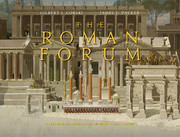Book contents
- Frontmatter
- Map
- Contents
- Preface
- Acknowledgments
- Part I. Architecture in the Roman Forum during the Empire: A Brief History
- Part II. The Monuments
- 3 The Temple of Antoninus and Faustina
- 4 The Temple of Caesar (Aedes divi Iuli)
- 5 The Basilica Æmilia
- 6 The Curia
- 7 The Arch of Septimius Severus
- 8 Minor Monuments
- 9 The Temple of Concord
- 10 The Temple of Vespasian
- 11 The Tabularium
- 12 The Portico of the Dei Consentes
- 13 The Temple of Saturn
- 14 The Basilica Julia
- 15 The Arch of Tiberius
- 16 The Schola Xanthi
- 17 The Diocletianic Honorary Columns
- 18 The Temple of Castor and Pollux
- 19 The Parthian Arch of Augustus (19 BCE)
- 20 The Temple of Vesta
- Part III. Conclusions
- Glossary
- Notes
- Bibliography
- Sources for Coin Images from the Internet and for Other Images
- Index
17 - The Diocletianic Honorary Columns
from Part II. - The Monuments
Published online by Cambridge University Press: 05 March 2015
- Frontmatter
- Map
- Contents
- Preface
- Acknowledgments
- Part I. Architecture in the Roman Forum during the Empire: A Brief History
- Part II. The Monuments
- 3 The Temple of Antoninus and Faustina
- 4 The Temple of Caesar (Aedes divi Iuli)
- 5 The Basilica Æmilia
- 6 The Curia
- 7 The Arch of Septimius Severus
- 8 Minor Monuments
- 9 The Temple of Concord
- 10 The Temple of Vespasian
- 11 The Tabularium
- 12 The Portico of the Dei Consentes
- 13 The Temple of Saturn
- 14 The Basilica Julia
- 15 The Arch of Tiberius
- 16 The Schola Xanthi
- 17 The Diocletianic Honorary Columns
- 18 The Temple of Castor and Pollux
- 19 The Parthian Arch of Augustus (19 BCE)
- 20 The Temple of Vesta
- Part III. Conclusions
- Glossary
- Notes
- Bibliography
- Sources for Coin Images from the Internet and for Other Images
- Index
Summary
Antiquity
The seven large-scale pedestals that border the north side of the Via Sacra in front of the Basilica Julia (plans: Figs. 0.1, 17.2) originally supported honorary columns and statues (Figs. 0.3–4, 1.4–5, 17.1–6, 21.15–16, 24–26). Identical designs and spacing suggest a single construction project in the reign of Diocletian. The pedestals and their columns survived for two centuries after Diocletian’s death (311 CE). But, by the early sixth century, although some of the honorary columns may have still stood, most of the bases, stripped of their decorative marble revetments, supported primitive wood-and-masonry huts that housed workshops. Some huts were attached to the bases. For others, the builders removed parts of the bases and partially occupied their interiors. By the beginning of the nineteenth century, the deep fill that covered most of the central area in the Forum hid the remains of the pedestals, the huts, and the neighboring rostra.
Excavations
With the excavation of the adjacent Column of Phocas in 1817 or 1818, the first two of the bases (labeled 15F, G) reappeared. They had, the excavators noted, supported red granite shafts, the fragments of which may still be seen today adjacent to bases 15E and F (Fig. 17.4). During the construction of the walls that buttressed the fill around the Column of Phocas in 1835, the third base appeared. When the next four bases were cleared (1872–1874), the attached medieval huts were also revealed and, “to return the forum to its ancient appearance,” removed. A contemporary photograph shows that parts of the exteriors of the two east bases (15A, B) still stood. The next five (15C–G) were only partially preserved, but brick stamps found near several date them to the reign of Diocletian.
- Type
- Chapter
- Information
- The Roman ForumA Reconstruction and Architectural Guide, pp. 276 - 283Publisher: Cambridge University PressPrint publication year: 2015



